Overview
Finding social media influencers effectively can be a game-changer for your campaigns. First off, it’s all about identifying the right type of influencers who resonate with their audience. Think about their engagement levels—this is key! Next, you’ll want to define clear campaign objectives. What do you hope to achieve? This clarity can guide your approach.
Now, let’s talk about how to actually find these influencers. You can dive into social media searches or explore influencer marketing platforms. Have you tried using tools like Creator Check? They can really enhance your chances of forming successful partnerships.
Remember, understanding the dynamics of different influencer categories is crucial. By setting specific goals and leveraging the right tools, you can improve your overall marketing outcomes. So, what does this mean for you? It means you’re well on your way to making meaningful connections that can elevate your brand!
Introduction
Navigating the world of influencer marketing can feel pretty overwhelming, right? With social media constantly changing, it’s no wonder brands are starting to see just how powerful influencers can be when it comes to driving engagement and conversions.
So, how can marketers effectively identify and collaborate with these key figures? It’s essential to partner with influencers who not only align with your brand values but also resonate with your target audience.
What strategies can you use to make sure you’re making the right connections? This guide will walk you through the crucial steps to find social media influencers, offering insights into the types, methods, and best practices that will elevate your marketing efforts and help foster authentic connections in 2025 and beyond.
Understand Influencer Marketing Basics
Influencer marketing is all about teaming up with individuals who have a solid following on social media. By leveraging their trust and authority, you can effectively promote your products or services. Let’s break down some key concepts that are essential for making this work:
-
Influencer Types: It's important to know the different categories of influencers—nano, micro, macro, and mega. Did you know that nano-influencers often have higher engagement rates? In fact, 75.9% of Instagram influencers fall into this category. Their smaller, more committed audiences can lead to genuine connections and increased trust.
-
Platform Dynamics: Each social media platform has its own vibe that influences how content is consumed and shared. For instance, TikTok is fantastic for driving discovery and engagement, especially among younger folks, while Instagram shines when it comes to building community and telling visual stories. Getting a handle on these dynamics helps you tailor your approach for each platform.
-
ROI Measurement: When it comes to measuring the success of your promotional campaigns, it’s not just about tracking sales. You’ll also want to look at engagement rates, reach, and conversions. In 2025, 66.4% of marketers said that integrating AI improved their campaign outcomes. This really highlights how important data-driven strategies are for evaluating ROI.
-
Streamlined Management with Creator Check: To make your marketing efforts with creators even smoother, consider using Creator Check. This platform ensures email security and data privacy with enterprise-grade encryption and GDPR compliance. Plus, it simplifies management by letting you handle multiple inboxes from different providers. With features like the Brand Book, you can efficiently manage communications and search across all creator emails, focusing on securing brand deals for your creators. This ultimately makes your agency operations more efficient and boosts revenue.
By getting a grip on these basics and using tools like Creator Check, you’ll be better equipped to navigate the influencer landscape and understand how to find social media influencers to make informed decisions that elevate your marketing strategy. So, what are you waiting for? Let’s dive into the world of influencer marketing together!
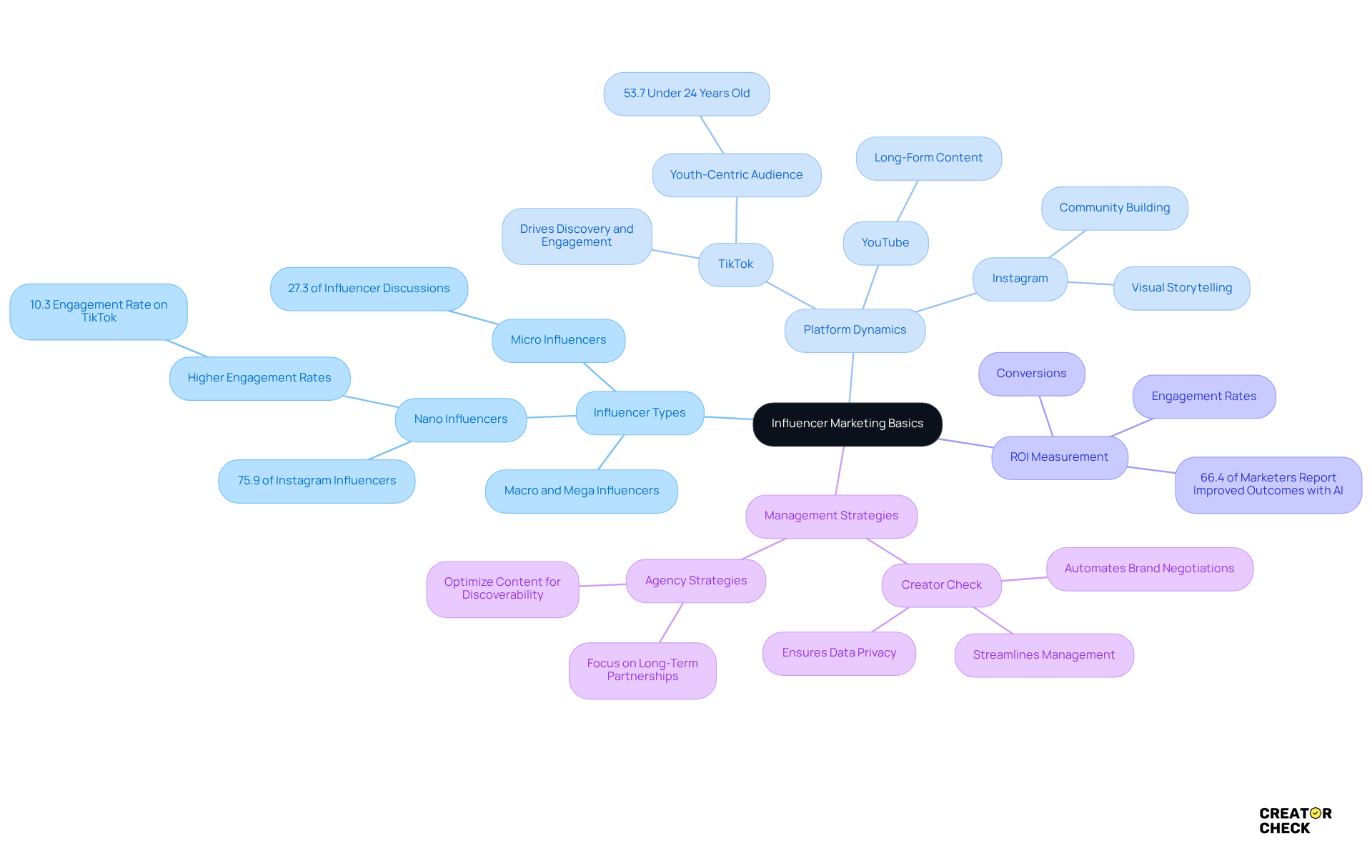
Identify Types of Influencers Relevant to Your Brand
To effectively identify influencers, let’s consider a few types that might just fit your needs:
-
Nano Influencers: These folks typically have fewer than 10,000 followers, but don’t let that fool you! They boast exceptionally high engagement rates, often achieving double or triple the interaction levels of larger accounts. Their close-knit communities foster authentic connections, making them perfect for brands looking for genuine endorsements.
-
Micro Creators: With follower counts ranging from 10,000 to 100,000, micro creators shine in niche markets. They’re seen as opinion leaders within their communities and can achieve engagement rates up to 60% higher than macro influencers. Brands are increasingly opting to collaborate with these micro advocates due to their cost-effectiveness and ability to foster meaningful interactions.
-
Macro Influencers: These influencers have between 100,000 and 1 million followers. They strike a balance between reach and engagement, making them suitable for brands aiming to expand visibility while still keeping a personal touch. Just keep in mind that their costs can vary significantly based on audience size and engagement metrics.
-
Mega Personalities: Often celebrities or well-known figures with over a million followers, mega personalities offer massive reach. While they can boost product recognition, their endorsements might lack the genuineness that lesser-known promoters provide, which can lead to lower engagement rates.
Now, assessing how to find social media influencers that align best with your company's objectives and target audience is essential for ensuring a successful partnership. As we look ahead to 2025, companies are increasingly focusing on micro and nano influencers for better engagement and improved ROI, moving away from the traditional reliance on mega influencers. Plus, using Creator Check's AI-driven solutions can simplify managing these partnerships while ensuring data security and privacy—crucial aspects in today’s digital landscape. So, what does this mean for you? It’s all about finding the right fit to foster those valuable connections!
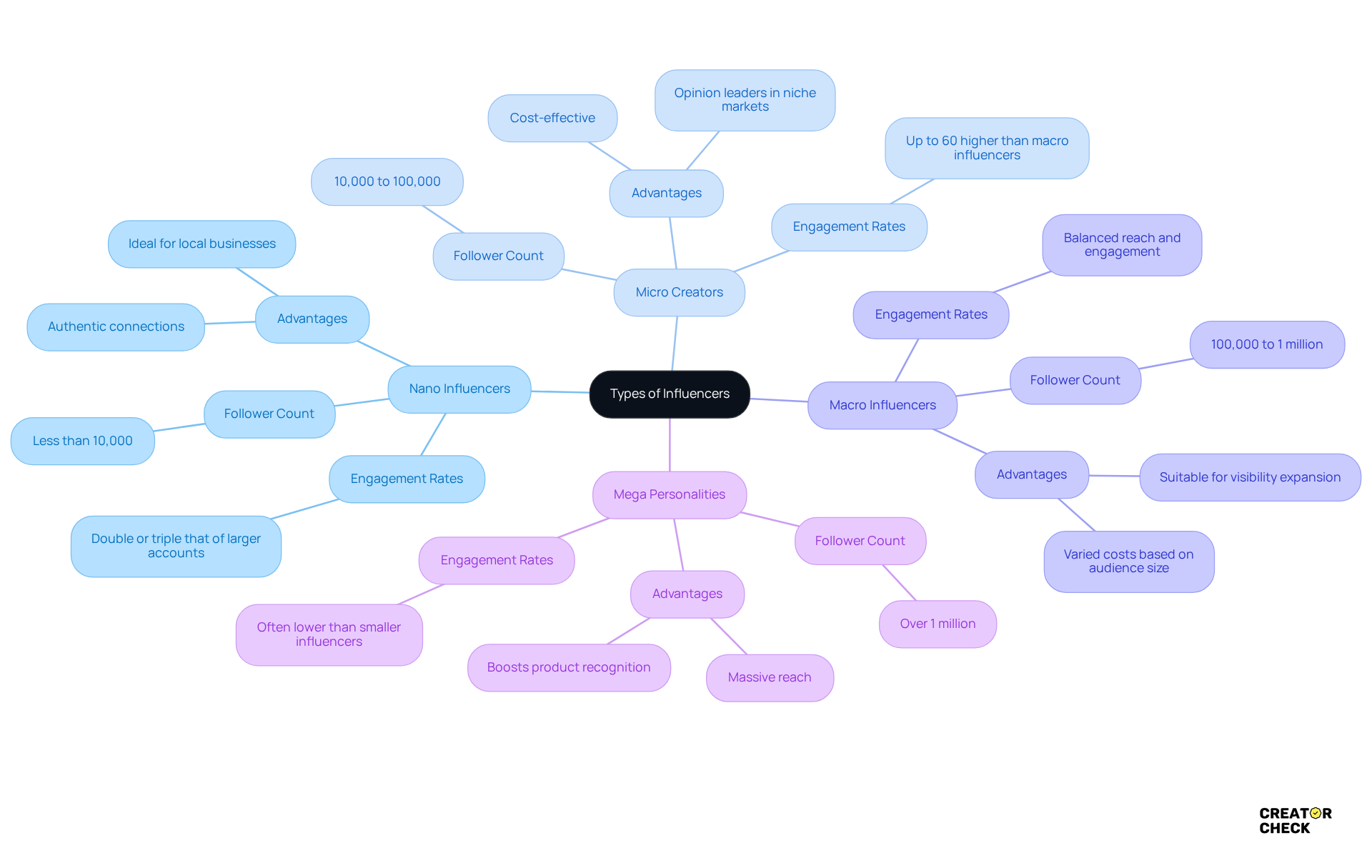
Define Your Campaign Objectives and Target Audience
Start by clearly outlining your campaign objectives:
- Brand Awareness: Focus on boosting visibility and getting your brand recognized. Did you know that brands with specific goals are four times more likely to succeed in their influencer marketing initiatives? Pretty impressive, right?
- Engagement: Aim to spark interactions with your audience through likes, comments, and shares. Engagement rates on platforms like TikTok can hit 10-15%, which can really amplify your brand's visibility.
- Conversions: Set goals for driving sales or sign-ups through influencer promotions. It's worth noting that influencer marketing can deliver an impressive return of 5€ for every 1€ spent—definitely a powerful tool for conversion.
Next up, let’s define your target audience:
- Demographics: Identify key factors like age, gender, location, and interests. Understanding these elements is crucial for learning how to find social media influencers who truly resonate with your brand.
- Psychographics: Dive into their values, lifestyles, and purchasing behaviors. This deeper understanding allows for more tailored messaging and collaboration with key figures.
By establishing clear objectives and a well-defined target group, you can effectively customize your influencer selection and campaign strategies, which will help you understand how to find social media influencers that align with your marketing goals for 2025. Plus, with Creator Check's enterprise-grade encryption and compliance with GDPR, you can manage sensitive information securely while keeping your focus on campaign success. As Rocky Bello puts it, "there is nothing worse than a confusing campaign with no clear guidelines and directions." This really underscores the importance of clarity in your campaign objectives.
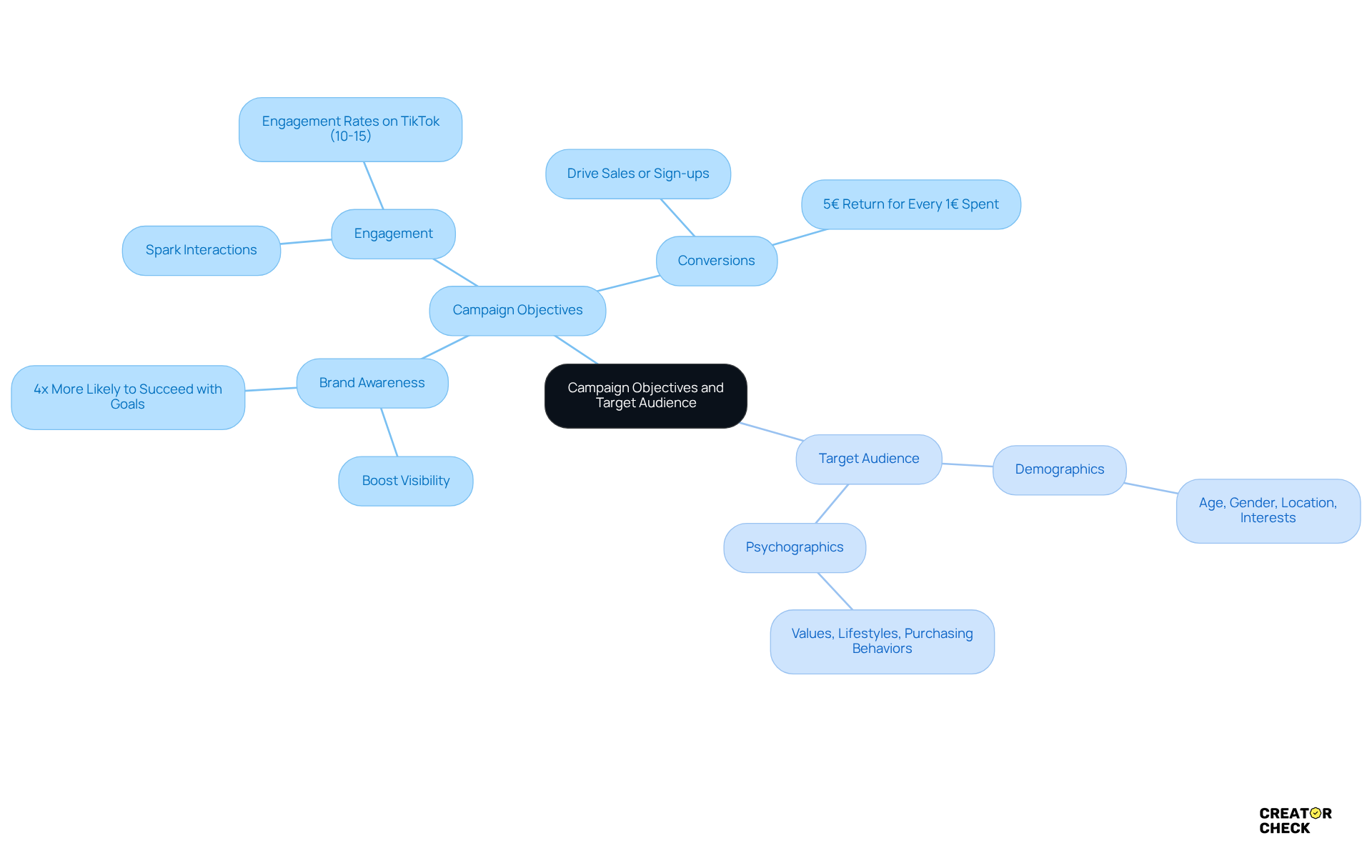
Explore Effective Methods to Find Influencers
To find influencers effectively, consider these methods:
- Social Media Searches: Leverage relevant hashtags and keywords on platforms like Instagram and TikTok to uncover influencers within your niche. For instance, using location-based hashtags can help you spot local figures who connect with your intended demographic.
- Influencer Marketing Platforms: Tools like Upfluence, Modash, and Heepsy are fantastic for accessing comprehensive databases of influencers. These platforms let you filter by engagement rates, audience demographics, and past collaborations, streamlining your selection process. It's worth noting that 49% of consumers' daily, weekly, or monthly purchases are influenced by content from these influencers, highlighting how crucial effective partnerships can be.
- Competitor Analysis: Take a look at the key figures your competitors are teaming up with. This can reveal potential collaborators who already understand the industry and audience, helping you avoid overlapping partnerships. By examining your competitors' partnerships, you can gain insights into individuals likely to connect with your target market.
- Networking: Attend industry events and engage in online communities to connect with key figures directly. Personal interactions can nurture connections and provide insights into whether these figures align with your values. As Rashmi Singh points out, making sure the promoter's audience matches your target demographic is vital for successful collaborations.
Integrating these techniques will greatly boost your chances of learning how to find social media influencers who resonate with your brand's principles and goals, especially as marketing through social figures evolves in 2025. So, what does this mean for you? It means that by employing these strategies, you can create meaningful connections that drive your brand forward.
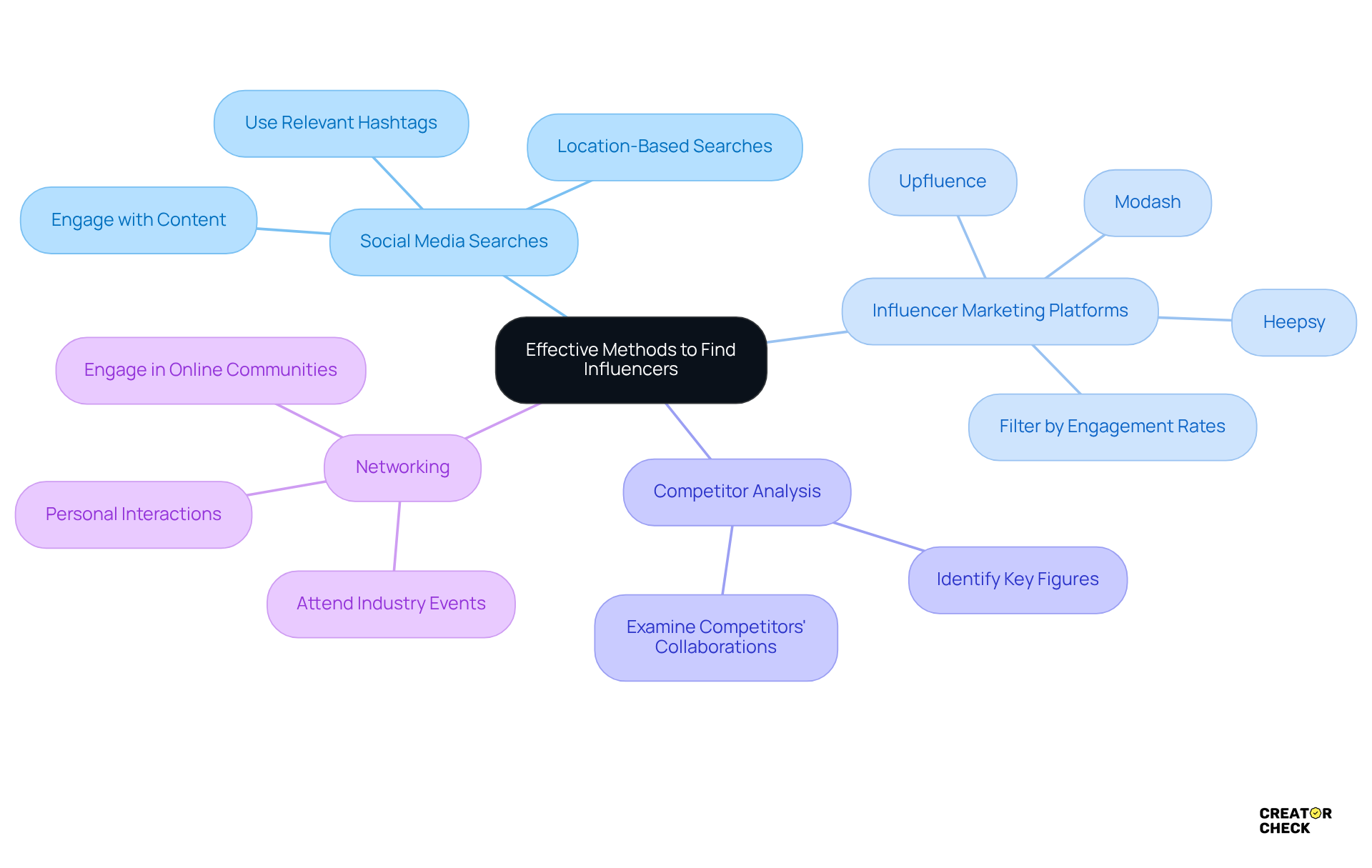
Vet Influencers for Brand Alignment and Authenticity
When you're vetting influencers, it’s super important to think about a few key criteria:
- Engagement Rates: First off, look for influencers with high engagement rates compared to their follower count. As we head into 2025, engagement rates are becoming a must-have metric for gauging how well someone connects with their audience. Micro-content creators often hit engagement rates of 5-8%, which shows they have an interested and engaged group of followers. This is essential for forming effective partnerships!
- Content Quality: Next, take a peek at the quality of a creator’s past posts. You want to make sure their content vibes with your brand’s messaging and aesthetic. Today’s consumers are all about authentic storytelling and relatable content—they prefer genuine narratives over anything that feels staged.
- Follower Demographics: Don’t forget to check out the demographics of a creator’s followers. You want to ensure they match your target audience. Understanding their interests and behaviors is key to making sure your partnership resonates with potential customers.
- Past Collaborations: Also, look into their history of corporate partnerships. This can give you a sense of their professionalism and reliability. Successful collaborations usually come from shared values and mutual benefits, not just transactional relationships.
And here’s something else to consider: how security and data management play into partnerships with social media personalities. Making sure that sensitive data is handled securely can really help build trust and transparency—both of which are crucial for authentic collaborations. By thoroughly vetting influencers based on these criteria, you can discover how to find social media influencers who will genuinely represent your brand and engage your audience effectively. This ultimately leads to higher conversions and stronger, long-term relationships!
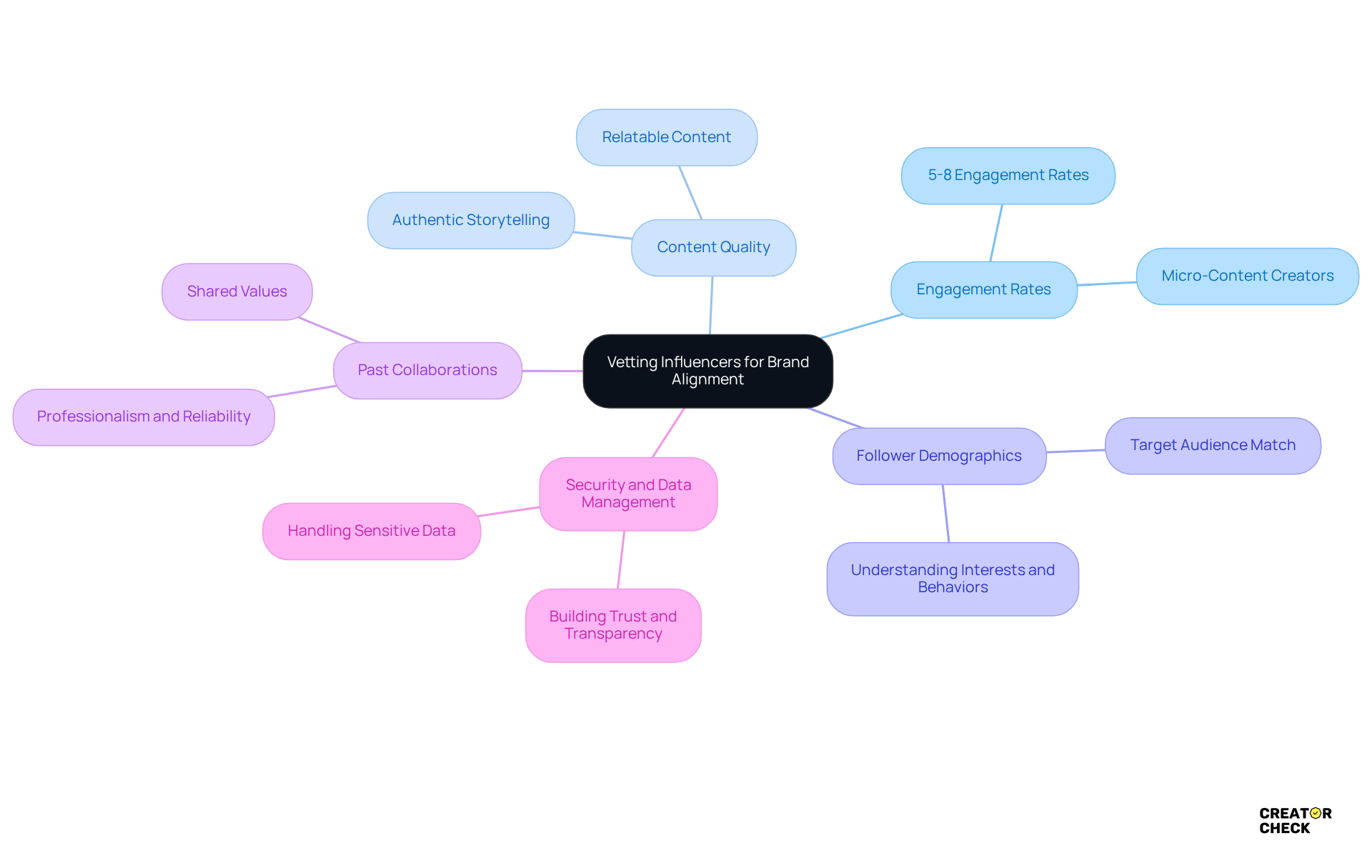
Negotiate and Collaborate with Selected Influencers
-
Set Clear Expectations: It’s important to outline deliverables, timelines, and compensation right from the start to avoid any misunderstandings. This clarity is crucial, especially since over 90% of social media marketers use bundling as a negotiation strategy—it really can make things easier.
-
Discuss Content Rights: Let’s talk about how the content will be used and if it can be repurposed across different marketing channels. Taking this proactive step helps dodge any legal hiccups and makes sure both you and the contributor are on the same page about usage rights.
-
Build Relationships: Creating a collaborative vibe is key! Being open to the contributor's ideas and feedback can go a long way. Keeping a positive attitude and genuinely showing interest in their work can help build long-lasting partnerships, which are super important for sustained success in 2025.
-
Follow Up: Once the campaign wraps up, keep the conversation going to review results and chat about potential future collaborations. Staying involved can turn initial partnerships into lasting relationships. Companies that focus on building relationships often find they have stronger customer connections and more resilient marketing strategies.
By negotiating with transparency and respect, you can create successful partnerships that bring mutual benefits for both your brand and the influencer.
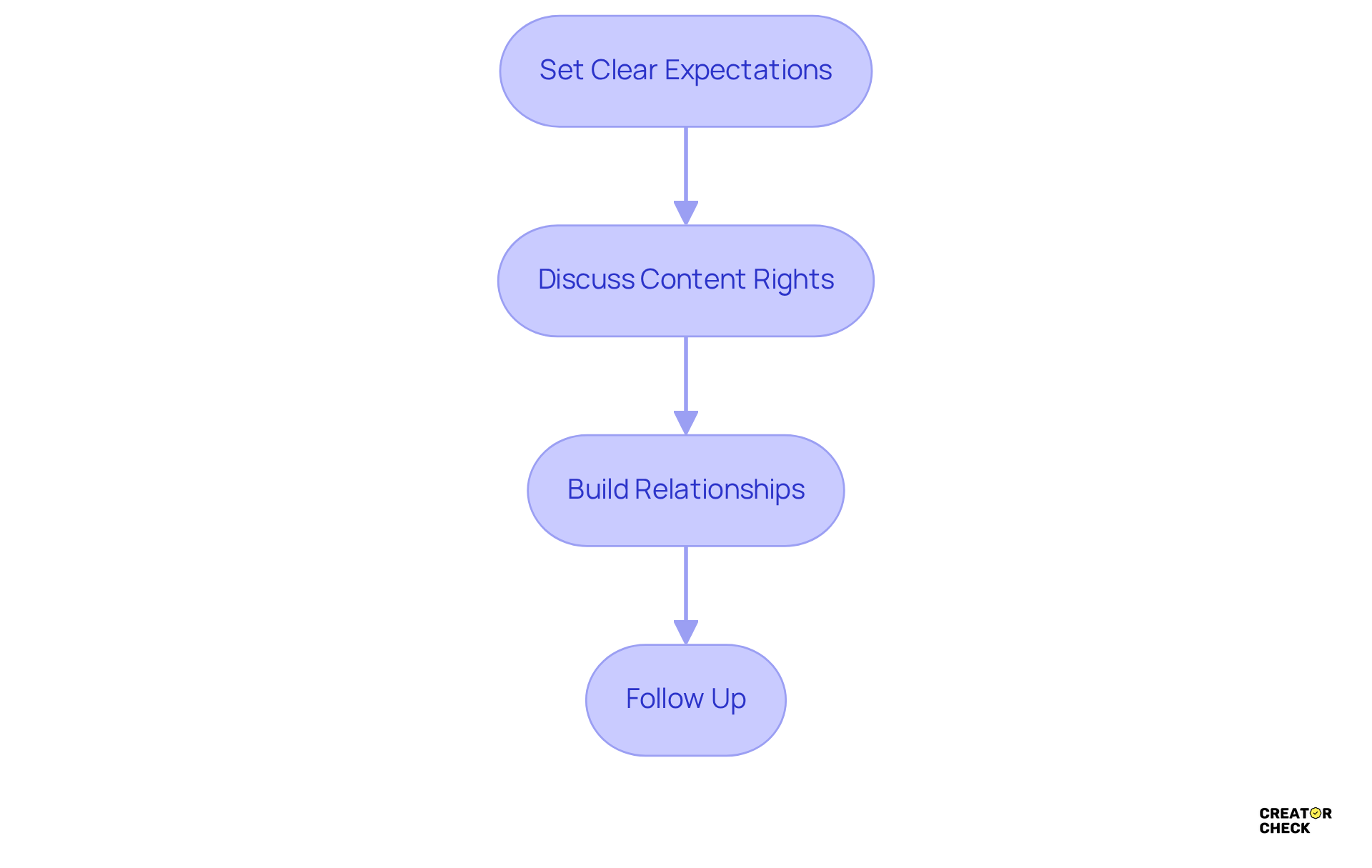
Conclusion
Finding social media influencers is super important for brands that want to tap into the power of influencer marketing. By understanding the different types of influencers and what they bring to the table, brands can create partnerships that truly resonate with their target audiences. Plus, using effective tools like Creator Check makes the whole process smoother and more secure, boosting the chances of running successful campaigns.
So, what are the key takeaways? It’s all about:
- Identifying the right influencers
- Setting clear campaign goals
- Really getting to know your target audience
By using smart strategies like social media searches, influencer marketing platforms, and even checking out what competitors are doing, you can significantly increase your chances of finding influencers who align with your brand values. And don’t forget—vetting influencers for authenticity and engagement is crucial for building genuine connections that lead to better conversions and lasting relationships.
In today’s fast-paced marketing world, the importance of influencer partnerships can’t be overstated. Brands should take proactive steps in their influencer marketing strategies, focusing on building authentic relationships and keeping communication clear. By doing this, companies can not only boost their brand visibility but also create meaningful connections that drive engagement and conversions. Embracing these practices will definitely set brands up for success in the ever-changing landscape of influencer marketing.
Frequently Asked Questions
What is influencer marketing?
Influencer marketing involves partnering with individuals who have a significant following on social media to promote products or services, leveraging their trust and authority.
What are the different types of influencers?
The main types of influencers are: - Nano Influencers: Fewer than 10,000 followers, known for high engagement rates and authentic connections. - Micro Creators: 10,000 to 100,000 followers, effective in niche markets with higher engagement rates than macro influencers. - Macro Influencers: 100,000 to 1 million followers, balancing reach and engagement, suitable for brands seeking visibility. - Mega Personalities: Over 1 million followers, typically celebrities, offering massive reach but potentially lower engagement.
Why are nano influencers effective for brands?
Nano influencers have smaller, more committed audiences that foster genuine connections, often leading to higher engagement rates compared to larger accounts.
How do social media platforms affect influencer marketing?
Each platform has its unique characteristics; for example, TikTok is great for discovery and engagement among younger audiences, while Instagram excels in building community and visual storytelling.
How can brands measure the success of influencer marketing campaigns?
Success can be measured through various metrics, including engagement rates, reach, conversions, and sales. Data-driven strategies, such as integrating AI, can significantly improve campaign outcomes.
What is Creator Check and how does it help in influencer marketing?
Creator Check is a platform that enhances marketing efforts with creators by ensuring email security and data privacy, simplifying management of multiple inboxes, and providing tools for efficient communication and brand deal management.
Why are micro and nano influencers gaining popularity among brands?
Brands are increasingly focusing on micro and nano influencers for better engagement and improved ROI, moving away from traditional reliance on mega influencers due to their authenticity and cost-effectiveness.
What should brands consider when identifying influencers?
Brands should assess how well influencers align with their objectives and target audience to ensure successful partnerships, focusing on engagement and authenticity rather than just follower count.




